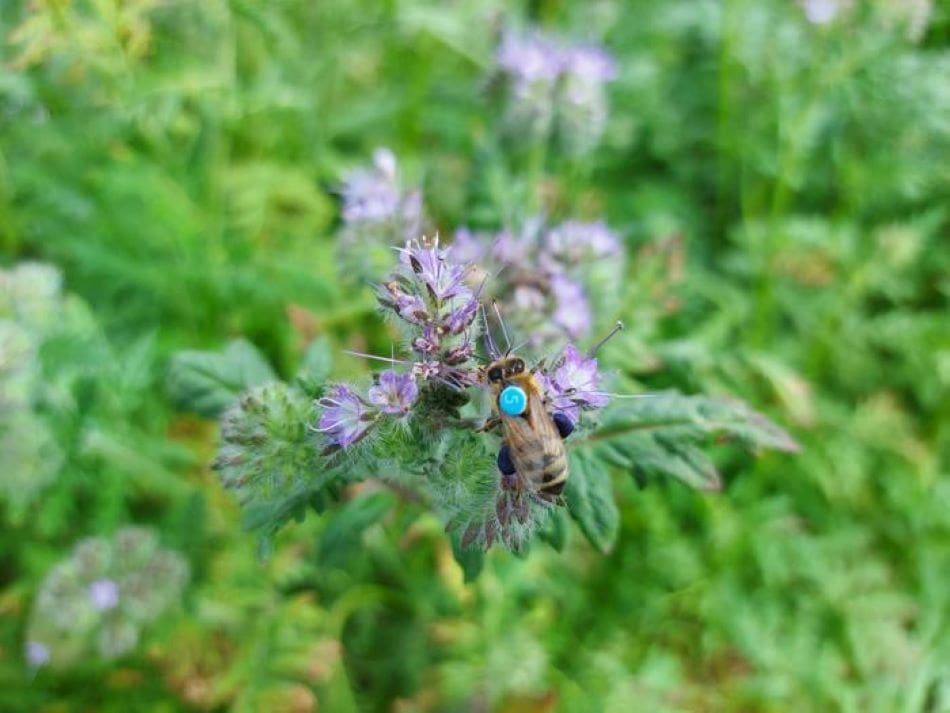Summary:
Honeybees are essential pollinators whose survival depends heavily on successful pollen foraging. New research published in Environmental Science & Technology explores how even low levels of pesticide exposure can interfere with this critical behavior. A team led by Ming Wang combined field experiments, artificial intelligence (AI)-based monitoring technology, and computer simulations to understand the effects of the neonicotinoid pesticide imidacloprid on honeybee colonies.
Using the BEEHAVE simulation model alongside real-world tracking of bees, the researchers found that sublethal pesticide exposure significantly reduced pollen foraging efficiency without majorly affecting nectar collection. Bees exposed to imidacloprid took longer pollen trips, foraged less frequently, and showed signs of cognitive impairment, leading to altered foraging patterns that ripple through the entire colony.
The study not only replicated results from previous experiments but also highlighted how combining AI tools with ecological modeling can improve predictions of pesticide risks. By linking individual bee behavior changes to broader colony impacts, this approach offers a promising new method for pesticide risk assessment. The findings provide fresh insights into how real-world pesticide exposure could threaten pollinator populations and, ultimately, the ecosystems that depend on them.

Simulations predict how pesticides may affect honeybee colonies
Honeybees are essential pollinators for agriculture and natural ecosystems. Stressors like climate change, habitat loss and pesticide exposure threaten their ability to forage for pollen, a critical resource for colony survival. Researchers in ACS’ Environmental Science & Technology demonstrate that an artificial intelligence (AI)-based monitoring system combined with a computer model can link the exposure of neonicotinoid pesticides on individual honeybees to the health of the whole colony.
Neonicotinoid pesticides are widely used in agriculture. Plants absorb and distribute neonicotinoids throughout their tissues, making the plant’s pollen potentially harmful to honeybees. According to past field studies, neonicotinoid-exposed bees make fewer trips to collect pollen throughout the day. However, the connection between changes in individual honeybee pollen-foraging behavior and overall colony health hasn’t been widely researched. Now, a multidisciplinary team led by Ming Wang hopes to change this by combining field study data with computer modeling and AI-based monitoring.
The researchers repeated their 2019 pollen-foraging field experiments where they exposed honeybees to sublethal doses of neonicotinoids and then tracked the insects’ activities with AI-based camera technology and traditional ecotoxicology methods. In this experiment, they analyzed the recently collected data using a computer simulation called BEEHAVE, which was designed to explore stress effects on honeybee colony dynamics.
Using their new approach, the team members found that even low neonicotinoid pesticide exposure led to less efficient pollen foraging on the individual and colony levels, which confirms their previous studies. “We were surprised that we could replicate the findings of our first field experiment in 2019,” says Silvio Knaebe, one of the researchers. “Honeybee colony behavior varies so much that statistically significant effects are difficult to detect.”
Given these initial results, the researchers say their new model, with pollen-foraging behavior as a key parameter, could be a unique candidate for pesticide risk assessment in the field at both the individual honeybee and colony levels.
***
The authors acknowledge funding from the Federal Ministry of Food and Agriculture (Bundesministerium für Ernährung und Landwirtschaft) via the Federal Office for Agriculture and Food (Bundesanstalt für Landwirtschaft und Ernährung), Germany.
Journal Reference:
Ming Wang, Frederic Tausch, Katharina Schmidt, Matthias Diehl, Silvio Knaebe, Holger Bargen, Farnaz Faramarzi, and Volker Grimm, ‘Reduced Honeybee Pollen Foraging under Neonicotinoid Exposure: Exploring Reproducible Individual and Colony Level Effects in the Field Using AI and Simulation’, Environmental Science & Technology 59 (10), 4883-4892 (2025). DOI: 10.1021/acs.est.4c13656
Article Source:
Press Release/Material by American Chemical Society (ACS)
Featured image: Neonicotinoid pesticides can reduce honeybee pollen foraging, potentially affecting colony health. Credit: Katharina Schmidt




